Ваш пас: Порођај код куће и првих 48 сати

Ако је ваша керуша скотна, можда ћете се одлучити да се оштени код куће, уместо да је водите ветеринару. Ако је то случај, постоји низ ствари које би требало да урадите пре него што стигне велики дан како бисте били сигурни да ће ваша керуша и њени штенци бити што здравији.
Иако ћете можда желети да се она оштени код куће, важно је да имате ветеринара ког можете позвати ако се ствари закомпликују. Његова стручност је непроцењива и моћи ће вам пружити подршку да сви штенци буду оштењени безбедно.
У свом дому ћете морати да издвојите одређено подручје у којем ваша керуша може да се оштени. Важно је да је ово подручје правилно сређено како бисте обезбедили да керуша буде без стреса и да јој је удобно, а да штенци имају најбољи могући почетак. Ево неколико важних ствари које треба имати у виду.
Кутија за рађање (или „штенење“) за вашу керушу
Она би требало да буде направљена од непорозног материјала, да се лако чисти и да одговара величини ваше керуше и њеног легла. Покријте основу кутије материјалима која задржавају топлоту и које можете извадити ради лакшег чишћења: пешкири, чаршави или новине су идеални. Ако имате керушу тешку преко 15 кг, поставите шипке на 10-15 цм од пода и бокова бокса како бисте спречили мајку да пригњечи штенад кад легне.
Пресудни фактори за порођај у кући: топлота, влага и ваздух
Тек оштењени штенци могу лако изгубити телесну топлоту и дехидрирати, тако да је неопходно одржавати место рођења на одговарајућој температури и влажности. Користите посуде с водом или овлаживач ваздуха да би простор задржао ниво влаге од 65-70% и радијатор или инфрацрвене лампе за загревање простора.
У прва четири дана живота штенета, његово окружење треба држати на температури између 29,5 – 32° C. Након тога, температуру можете постепено смањивати на приближно 26,7°C током седам до десет дана, а онда на 22,2°C до краја четврте недеље живота штенаца. Кутија за рађање такође треба да буде у добро проветреном подручју на ком није превелика промаја нити је загушљиво.
Нека порођај керуше код куће буде хигијенски
Простор за рађање треба одржавати изузетно хигијенским, што значи ограничавање броја људи који улазе у то подручје, као и честе дезинфекције и чишћења. Добро се побрините за личну хигијену пре него што уђете у то подручје, а пре него што керушу уведете у простор за рађање, оперите је или очеткајте како бисте се решили што више паразита или бактерија.
Упознајте своју керушу са простором за рађање
Да бисте били сигурни да је ваша керуша осећа срећном и опуштеном када се штени, требало би да је упознате са местом за рађање и боксом недељу до две пре очекиваног датума порођаја. Нека њој и том простор не прилазе друге одрасле животиње како бисте избегли инфекцију и уверите се да јој је пријатно у простору.

Након порођаја пса код куће
Штенци су веома осетљиви током прве три недеље живота. Нарочито првих 48 сати могу да буду пресудни за то да ли ће се развијати здраво. Недостатак кисеоника и инфекције су највећи ризици током порођаја, па је важно следити горе наведене савете како бисте припремили подручје за порођај и смањили тај ризик.
Након успешног порођаја, леглу можете пружити најбољи могући почетак на неколико једноставних начина.
Потрудите се да штенци почну да сисају мајчине сисе што пре након рођења. Уместо да уноси млеко, легло уноси колострум, супстанцу коју производи мајка и која подржава и јача имуни систем штенаца. Колострум се мора узимати током првих 12 до 16 сати, зато подстакните новорођену штенад да одмах сисају.
Препоручује се редовно мерење штенаца ради прегледа њиховог стања и напретка. Штенце који не успевају да повећају тежину или почну да мршаве треба што пре да прегледа ветеринар. Такође треба да препознате штенце са малом тежином на рођењу како бисте могли да их надгледате и помажете.
Мала тежина на рођењу значи да због бржег метаболизма и других фактора штенци брже губи топлоту и енергију. Штенци се рађају са само 1-3% тежине у односу на своју мајку, а мала тежина на рођењу је свака која се налази у доњем квартилу за расу вашег пса.
Ако се обави на одговарајући начин, порођај код куће може помоћи вашем псу да се осећа опуштено док се порађа. Ваша улога је да пажљиво припремите дом и пружите штенцима потребну негу у тих пресудних неколико првих дана.

Прилагођена исхрана за ваше штене
Низ формула које помажу у изградњи њиховог природног имунитета, подржавају здрав раст и развој система за варење.
Лајкуј и подели страницу